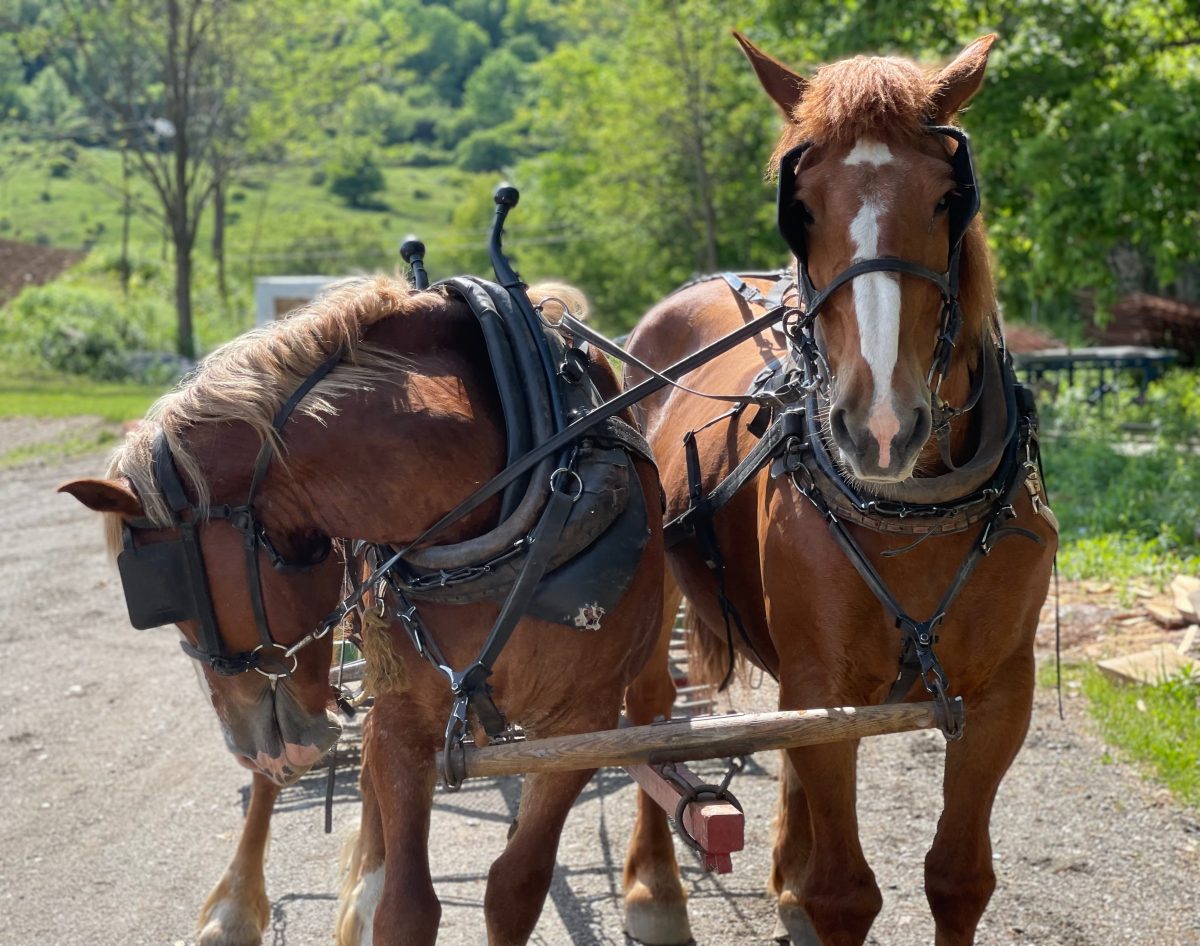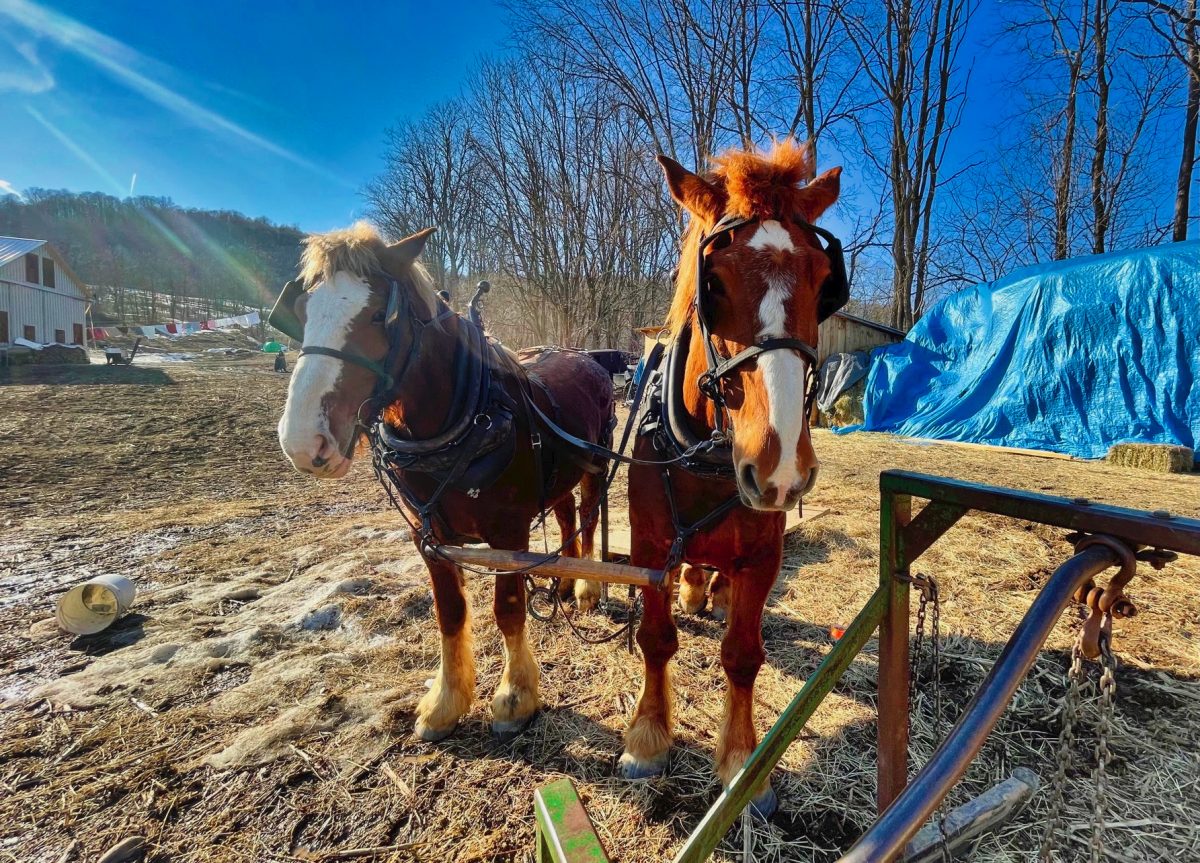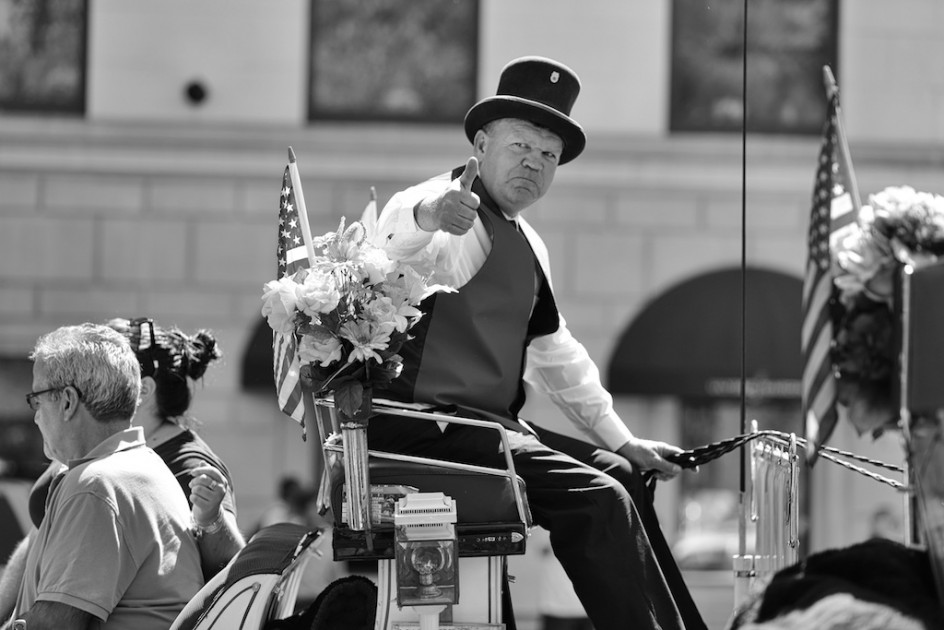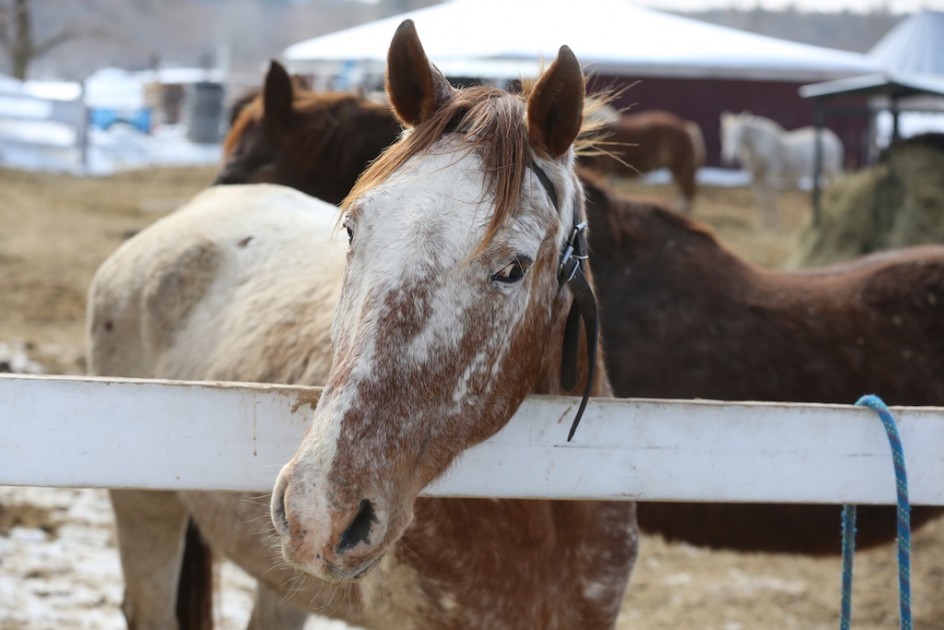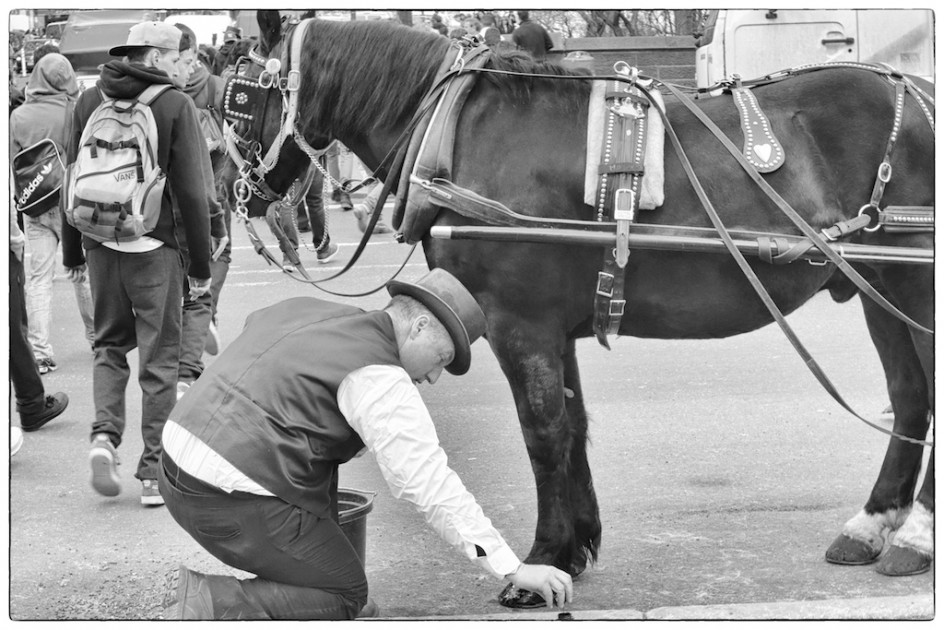“We need another and a wiser and perhaps a more mystical concept of animals.” – Henry Beston, The Outermost House.
What, you might wonder, do the simple, hard-working, and plain Amish have in common with the flamboyant, outspoken, and individualistic men and women of the New York Carriage Horse trade?
A lot more than you might think, and a lot more than I thought until I got to know my Amish friends and neighbors and realized they and the carriage drivers have so much to teach us about the wonder of working animals and the urgent need to keep them in our lives and to work among us.
We owe these two groups a lot.
I’ve spent considerable time with both. Horses are central to both their lives.
Each has challenged me to understand animals in a different and new way and to think differently about how we might keep them in our troubled world.
I am struck by the fact that many Amish horses were once carriage horses in New York and elsewhere, and many carriage horses were bought from Amish farms.
That is an eerie connection. But it links the two groups.
The Amish and carriage horse drivers are not only keeping these magnificent creatures alive and in good health and working; they are showing the rest of us how it can and should be done.
It really can work.
If domestic work animals survive in our chaotic and greedy world, it will be because of people like the carriage drivers and the Amish.
The animal rights movement has lost its way, it has squandered the trust so many people gave them and failed the animals who so badly need real, not pretend, advocates.
The movement has lost touch with ordinary people who love animals, and the special breed of people who work with them. They are arrogant and elitist.
I no longer contribute to organizations like the ASPCA or the Humane Society. My checks go to local shelters and rescue groups – many are actually helping animals to stay alive and among people.
I think it is true that the road to Hell is paved with good intentions.
It’s too late for the elephants and the ponies who gave rides to children.
It’s too late for many draft horses who were run out of cities by animal no-nothings.
They were done in by good-hearted but oblivious people who think they are animal advocates.
In most places, carriage horses, like elephants and ponies, have been banished and given death sentences in exchange for a way to live alongside human beings.
Unlike so many of their kind in the wild, they were sheltered and protected and fed, and in many cases loved.
It’s not too late for the horses, these extraordinary, adaptable, and proud creatures who live to work with us, not harm us. A lot of them are still around. But they – we – are running out of time.
Tragically, the core organizations of the animal rights movement have gotten it upside down. They’ve all been bought into the suffocatingly narrow PETA idea of animal rights. In America, everyone follows the money, and PETA has the money.
In 2016, PETA had total revenue of $67 million.
PETA spent $16 million of those dollars on Research, Investigations, and Rescue.”
According to journalists, PETA spends less than one percent of its budget actually helping animals. In that year, the group euthanized more than 1,900 animals or 85 percent of the animals it received.
Instead of attacking and harassing people who want to work with animals, like the Amish and the Carriage Drivers, the animal rights movement should be thanking them and showering them praise and support. They keep animals alive.
Honestly, what kind of animal rights organizations battles for the right of more than 200 safe and sheltered working horses to be sent to almost certain death rather than ride around Central Park in light carriage horses and go home to sleep and eat.
Isn’t the idea for them to be protecting these horses?
The Amish and the carriage drivers have saved more animals than PETA will ever figure out how to do. The animal rights movement has produced a failed and morally bankrupt agenda for animals and animal lovers.
If you stand in Central Park for an hour, or on an Amish farm for ten minutes, or watch them ride their carts into cities and towns, you will not see any abuse of animals.
You will see all kinds of people, Amish, and visitors and children lining up to touch these animals, wonder at them and try to touch and love them.
Everywhere the horses go people smile and watch and wave.
Horses touch some of the deepest things in us, perhaps because they were our partners and lifesavers for thousands of years.
We literally built the modern world with them and settled distant places and created the future with them.
It is a beautiful thing to see people smile as they see the animals in central park, or the Amish buggies riding into town.
We owe them so much. We have let them down.
Some people complain that the Amish should get off their roads: I would argue the horses came first and are entitled to the right of way. Would the world be a better place if those cars got off of our road instead of the horses?
Like the Republican Party, the national animal rights movement has embraced the idea of the Big Lie – in this case, people can’t be trusted with animals.
I’ve seen and read too many heartbreaking stories of people who love their animals dearly and have seen them taken away from them because it is now, for the first time in human history, seen as cruel for them to work with us.
The animal rights movement has failed to create a vision for animals that can unite those of us who love them and bring us together.
Today, the once-promising movement has become just another organization that lives in its own self-centered world and cannot unite us around a common vision. It doesn’t even bother to try.
The animals deserve better.
The dominant animal rights idea is that animals like horses, elephants, and ponies must be removed from human life and protected from us.
PETA, the ASPCA, the Humane Society have banded together to forge to threaten working horses, working domestic elephants, ponies that give rides to children and dogs and cats.
They have advanced the great lie that hauling light carriages in central park in moderate weather under the supervision of five different New York City government agencies, is cruel for them.
They insist life in a circus is cruel and abusive but have produced precious little evidence to prove this is sol
They argue that the horses and elephants would be better off in some mythical preserve staring at trees for the rest of their lives.
They claim there are dozens of these refuges, but so far, in six years of fighting, they haven’t named one.
They defend themselves by saying that work for animals on a farm is a form of abuse. They have also singled out the Amish as animal abusers.
They have made it impossible for children to ride on ponies, for elephants to be in circuses, for horses in many cities to pull carriages.
Instead of working hard to keep animals among us, they work feverishly and without any kind of animal familiarity to take them away.
Of course, they hate the Amish and the Carriage Drivers; they are living proof that the animal rights mission is both corrupt and destructive and no longer has anything to do with rights.
In New York City, they have become just another hate group. We have enough of those.
How sad for the animal rescue movement, which does such good work with so little hate.
What is cruelty anyway? Condemning an active working animal to a life of isolation and sloth, or killing a horse that has worked hard and can’t work anymore.
Removal from the lives of human beings is not what animals need.
These horses need work as much as they need food. They have been working with us since ancient times.
Hard work is not cruel for them, it is what they live for.
Just ask all the dead elephants if they are better off since being driven from our circuses or the dead ponies and carriage horses.
Just where are those hundreds of elephants who were promised peaceful and eternal peace and retirement on those preserves? I can’t find more than one or two and they have room for a handful of elephants.
The animal rights movement has made it harder for the poor, the working class, people who can’t afford giant fences, and the elderly to adopt dogs and cats, even though millions of them are in desperate need of homes.
These are new and especially cruel ideas of pet adoption. Those Draconian limits were never considered necessary before.
The roads people want Amish carts to stay off of were built for and by horses. Horses have built our civilizations, fought in our wars, transported our children and us to go to school, buy food, visit family., hauled bricks, fought in wars, moved new generations of Americans across the country.
No animal has a greater right to live and work with us than a horse.
I’ve heard a lot of people say that horses should be banned from New York streets. No one is asking for donations to ban cars from the city. They kill thousands of people every year.
The horses don’t kill anyone.
If I’ve learned anything about my time with the New York Carriage Horses and the Amish, it’s that people who work with animals often take the best care of them.
They have no choice, for one thing. The Amish take meticulous care of their horses, they could not survive with them.
If you watch the animal rights activists in New York City, you will never see a single one look at a horse, touch one, or offer one a carrot. If these animals are so abused, that would be a merciful thing to do.
They are too busy harassing and threatening tourists and drivers.
Working animals need to work, it is essential to their well-being, mentally and physically, and there is little work for them to find in our congested world.
The people who go to the trouble of finding and training working animals most often get to know them, live with them, feed them, bond with them, keep them healthy and keep them alive.
The children of the future will only get to know ponies and elephants and the big horses from Youtube if the animal rights movement continues to create the narrative that defines how we see the future of animals: they must be taken away, we can’t keep them safe enough from us.
That does not go far enough. If they are all taken away, they will perish and we will never see them again, just like the elephants. Safety will not save them.
Work with people who care about them will save them.
It is so easy to manipulate animal lovers: just put a photo of a battered animal on the Internet and wait for the money.
I do not believe animals need to be protected from us, they need to be with us.
Some will be abused, that is the nature of some humans. Most will get to live and survive. That is the nature of most humans.
We need a new vision for animals.
The Carriage Drivers have one, so do the Amish.
And neither of them raises large amounts of money or works to get animals away from human beings or demonizes people. Without change, these animals will be forgotten, and no child will grow up seeing a single one.
That is a tragedy.
For me, the greatest right of any animal in 2021 is the right to live in our world and find a way to co-exist with and among humans, their only real chance of survival.
___
When Bill de Blasio became mayor of New York City in 2014, he promised that the priority of his new administration would be to ban the New York Carriage Horses from working in Central Park or anywhere in the city.
In a city with as many problems as New York City had and has, that was a shocking choice to make, another testament to the poisoning of our civic system by big money.
One of de Blasio’s major fundraisers, an animal rights activist, had given him a ton of money and persuaded him during the campaign that it was cruel for working horses to work in New York or any other city.
It was dangerous for the horses and the citizens of the city to have carriage horses clip-clopping to work every morning on the way to the park that was built largely for them, he argued.
It was a danger also to the citizens of the city, he insisted. (I was surprised to find out that in 100 years of operation, no resident of New York City had ever been killed by a Carriage Horse, and only a handful of horses had been injured after millions of rides.
(Falling trees in Central Park have killed more children than injured by a horse.)
In addition, his donor convinced the mayor, who has never in his life set foot in a carriage horse stables, that the animals were eating rotten food, sharing stables with rats, living in filthy conditions, being worked to death, and systematically abused.
I was curious to learn about this for myself, it just seemed off to me. I read a dozen equine veterinary reports that found the stables to be clean and the horses well cared for and healthy.
I spent a lot of the next two to three years visiting the horses in New York, going to see their stables, riding on carriages in the park, and talking to equine vets, and horse lovers like Buck Brannaman, the inspiration for Robert Redford’s Horse Whisperer.
There was a score of veterinary teams who sent into the stables. Every single one found the stables well run and the horses healthy and content.
None of that mattered to the animal rights groups, they just ignored it in exactly the way Trump supporters ignore the evidence that found the elections were legitimate. Is that an accident, I wonder, but one does bring me to think about the other.
Could this have been the launch of the Age Of Lies? Yoiks.
Brannaman told me (and wrote) that the carriage horses were the luckiest horses on earth; they got to work and were well cared for.
I talked to carriage drivers, read reams of studies on the horses by state, local, and federal horse vets, and pored through local animal rights sights, which were raising hundreds of thousands of dollars from people who believed the horses were being endangered and mistreated.
Now, some years later, the carriage horses are still in the city, de-Blasio is leaving office soon, and the animal rights campaign to get the horses out of the city and sent to mysterious “preserves” that no one could name or find has collapsed.
Polls show more than 70 percent of New Yorkers want the horses to stay, feel in no danger, and do not believe the claims of the animal rights groups.
It’s time for a new vision for animals, one that actually protects them.
Maria and I took a train up to New York right after de Blasio made his vow, and we both were stunned to visit the stables and to see the healthiest, most responsive, beautifully trained, and groomed and fed horses either of us had ever seen.
The carriage drivers welcomed us to the stables, let us walk freely, look at the feed, even go into the stables.
I have never seen such obedient, trusting, and responsive animals. They did everything asked of them without delay or complaint. They had the most powerful bonds with their drivers.
And what surprised me even more than that was that the animal rights organizations in New York, which I belonged to and gave money to, had a big truth problem. They were lying about every aspect of the carriage horses’ lives, temperament, and treatment.
___
Today, the Amish have given me a new perspective on the future of animals, as the Carriage Drivers in New York City did in 2014 and beyond.
As I connect the dots, they lead to one another in a number of ways, as different as they are.
There are many things about the Amish and the Carriage Drivers that fascinate me, I can’t help but compare the two experiences, especially when it comes to the horses.
Like the carriage horse drivers, they are a community of individuals that has rejected corporate American life – office jobs, a life centered on technology, work we hate, things people don’t need.
The carriage drivers and the Amish have created a world within worlds, and in many ways, it is more fulfilling than the one outside.
The Amish and the carriage drivers often work together; they buy horses from one another and share similar values: their horses are not pets to be coddled but partners in their lives.
The horses provide a living to the diverse and working-class carriage drivers and have many families through the centuries and in other countries.
Ireland has sent us many carriage horse drivers, as Europe sent us the Amish.
Both groups also have delighted and fascinated generations of tourists and children and the curious, they flock from all over the country and the world to see both groups.
The Amish and the carriage drivers share the awful experience of being targeted by animal rights activists who accuse them of wanton abuse of animals, often without evidence or even the most basic understanding of how animals live.
The drivers routinely get telephone calls and e-mails accusing them of being murderers and torturers of horses.
Every weekend the picketers show up in Central Park where the carriage riders come and carry signs accusing them of murder and abuse. It is a painful and often hateful thing to witness.
It gave me no pleasure to learn that the groups I joined and supported for so much of my life lie without hesitation or shame.
Today, they remind me of the people who insist the 2020 presidential election was fraudulent. They ignore facts they don’t like and claim that lies are the truth. I see that if you lie often enough, you will come to believe it.
Reality and honor have no meaning for them; they live in their own reality and manufacture their own truth as needed.
I’ve been writing about the Amish a lot lately, and this experience brings me back to the messages I used to get when I wrote about the carriage horses.
People tell me all the time that the Amish run puppy mills and abuse their horses. A lot of these people describe themselves as animal rights “activists.”
It doesn’t matter that the people I write about have done none of those things.
I’ve checked out my Amish neighbors in the same ways I checked out the carriage stables. The accusations are false when applied to them. I can’t speak for the others.
None of them have ever had puppy mills or plan to.
I’m sure some Amish people do have puppy mills, just as I am sure of every kind of people – black, white, yellow, Jewish, Christian – who have puppy mills or mistreat their horses or dogs.
That doesn’t mean everybody does it. But as I learned in New York City, the animal rights movement is founded on the idea of humans as villains. They raise a lot of money that way, just as Trump’s lies bring him millions more than he has.
The worse people are seen as being to animals, the more checks people write. That’s the underbelly of the modern animal rights movement.
The Big Lie works. It travels like the wind on our new digital information highway.
I was impressed with the New York Carriage Drivers. Several became good friends. A diverse and quarrelsome bunch of individualists care about their horses and lead their independent lives in peace.
In this, they remind of the Amish.
Amish farmers often have as many as 10 and 11 horses.
Some are smaller riding and cart horses; some are big draft horses good for plowing and heavy hauling.
The bonds between horses and humans are powerful in Carriage Horse stables and on Amish farms. You can see this for yourself; you don’t have to apply, be screened, or fill out a dozen forms and wear a badge. You can walk in and see for yourself, and you should.
The horses are almost ethereally calm, like the carriage horses. These huge animals do exactly what they are told to do.
Roaring trucks and motorcycles roar by within inches of them, and they don’t flinch or spook.
The horses give the almost gypsy-like carriage drivers identity and work.
The Amish horses give that community a way of pushing back the wave of technology and loneliness that disconnects and disrupts our lives.
Because they have no cars, they ride everywhere in carriages, from the local hardware store to relatives 50 miles away.
The horses are a statement, just like the carriages- we learn who they are and what they stand for.
Indeed, both the carriage horses and the Amish will often kill or euthanize their animals when they can no longer work. That is and has always been the reality of working animals. They are not soul mates or furbabies.
This is one of those places where it is time for us to learn from these people and not harass or persecute them. We live in a country where millions of children have no access to health care or enough healthy food.
We cannot afford to keep thousands of working animals like elephants and horses and ponies alive for all time at any cost. There is neither the money nor the will to do that.
Yet many people feel that killing old animals that can’t work any longer is always cruel and constitutes abuse. That is one of the new but deeply flawed visions about animals that need to change. It would be wonderful if all animals lived as long as possible by any means and at all costs.
It just can’t be. And it’s wrong and often cruel.
In the wild, animals don’t get to be kept alive beyond their ability to fend for themselves. If they were, every habitat would be overrun and thrown out of balance.
The Amish have figured out how to give thousands of horses work to do, a good place to live, hay, and fresh feed every day. When they can no longer work, they either sell them or shoot them.
Shooting an animal like a horse is quite often by far the most humane way for them to die. A bullet is a lot more merciful a death than a slaughterhouse in Canada or Mexico.
It is instant and painless.
I never met or saw a carriage driver who abused his horse. I’ve never seen a horse being starved, beaten, or in any way mistreated by an Amish person.
Their faith mandates kindness and empathy. You don’t get horses as obedient, calm, and responsive as they are by whipping or starving them.
They don’t see animals as pets in the way many of the “English” do; they don’t shower them with treats or gourmet food or toys the way I do.
But they keep them alive, and they give them work and purpose, and they allow us to see them and know them.
They can also help us address the heavy challenges of climate change – they don’t need fossil fuel to transport us and help us carry the heavy loads of civilization.
The Amish, in particular, have a powerful vision for a different way for animals to live. They keep them in their lives no matter what.
I like that, it feels like a good place to start.

